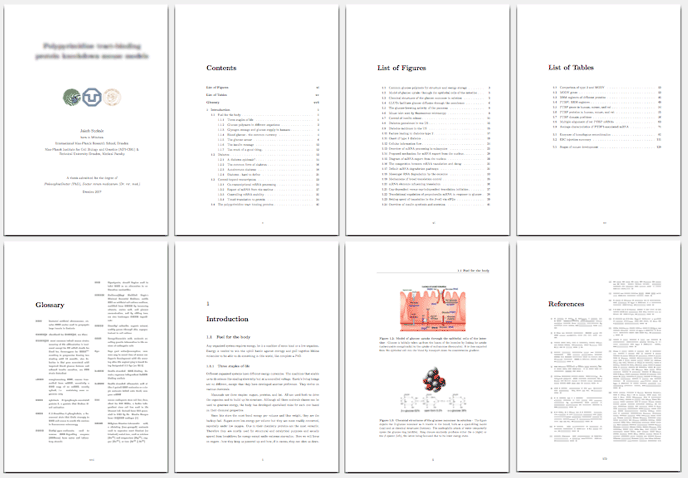LaTeX template for PhD thesis: Difference between revisions
(layout content) |
(download and use content) |
||
| Line 3: | Line 3: | ||
== Overview of template layout == | == Overview of template layout == | ||
Using this LaTeX template you will be able to produce a professionally typeset PDF document with useful features not found in most PDFs. Most of the document structure will be generated automatically without you having to set it up | Using this LaTeX template you will be able to produce a professionally typeset PDF document with useful features not found in most PDFs. Most of the document structure will be generated automatically without you having to set it up manually, saving you several hours of layout twiddling. Favourite features are the automatic placement of figures close to the text references and avoiding orphan lines (see below for a full list). | ||
[[Image:PhD-template-overview.png]] | [[Image:PhD-template-overview.png]] | ||
| Line 15: | Line 15: | ||
* automatic generation of reference section / bibliography at the end of the document (panel 8, bottom right) | * automatic generation of reference section / bibliography at the end of the document (panel 8, bottom right) | ||
The template does most of the layout work for you. Nevertheless, you can of course change the layout if desired. You might want a different citation style or you may not need an abstract. Many alternatives are given within the documents of the template as inactive lines (preceded by %), which can be | The template does most of the layout work for you. Nevertheless, you can of course change the layout if desired. You might want a different citation style or you may not need an abstract. Many alternatives are given within the documents of the template as inactive lines (preceded by %), which can be activated as desired by uncommenting (removing the % sign). | ||
== Download and use == | == Download and use == | ||
* download the archive with all the text files making up the template: [http://openwetware.org/images/0/08/PhDtemplateLATEX.zip PhDtemplateLATEX.zip] (2 MB) | |||
* unpack the archive after download | |||
* you will find a folder structure resembling the document (''0_frontmatter, 1_introduction,.. 9_backmatter'') | |||
* start by looking at the ''introduction.tex'' file in the folder ''/1_introduction''; it contains detailed comments explaining LaTeX and this template | |||
* you can start directly by changing by adding contents to the sub-document, e.g. the ''introduction.tex'' file | |||
* also add your personal information to the central document ''thesis.tex'' which calls up all the other sub-documents | |||
== See also == | == See also == | ||
Revision as of 03:18, 7 September 2007
This page describes a LaTeX template for writing up your PhD or DPhil. It can be downloaded from here. The template could also serve as a backbone for writing similar documents, like Bachelor and Masters theses. Using the template only requires minimal knowledge of LaTeX and contain in-line comments (lines starting with the % sign) explaining the most essential mark-up in the document, mainly the introduction.tex file. If you don't have a LaTeX environment on your computer, you can find instructions here (to be added later).
Overview of template layout
Using this LaTeX template you will be able to produce a professionally typeset PDF document with useful features not found in most PDFs. Most of the document structure will be generated automatically without you having to set it up manually, saving you several hours of layout twiddling. Favourite features are the automatic placement of figures close to the text references and avoiding orphan lines (see below for a full list).
- cover page with institution creast and personal details (panel 1, top left)
- automatic table of contents, automatic numbering of chapters, section,.. (panel 2)
- automatic listing of all figures and tables after the table of contents (panel 3 & 4, top right)
- automatic glossary in 2 columns (panel 5, bottom left)
- special layout for the start of a chapter, always on a main page (odd page number) (panel 6)
- easy placement of figures with bold title and indented caption below using a macro (panel 7)
- automatic generation of reference section / bibliography at the end of the document (panel 8, bottom right)
The template does most of the layout work for you. Nevertheless, you can of course change the layout if desired. You might want a different citation style or you may not need an abstract. Many alternatives are given within the documents of the template as inactive lines (preceded by %), which can be activated as desired by uncommenting (removing the % sign).
Download and use
- download the archive with all the text files making up the template: PhDtemplateLATEX.zip (2 MB)
- unpack the archive after download
- you will find a folder structure resembling the document (0_frontmatter, 1_introduction,.. 9_backmatter)
- start by looking at the introduction.tex file in the folder /1_introduction; it contains detailed comments explaining LaTeX and this template
- you can start directly by changing by adding contents to the sub-document, e.g. the introduction.tex file
- also add your personal information to the central document thesis.tex which calls up all the other sub-documents
